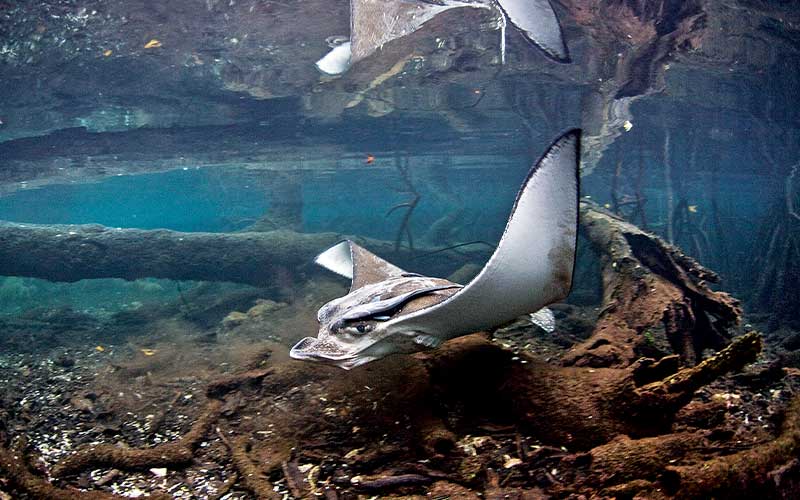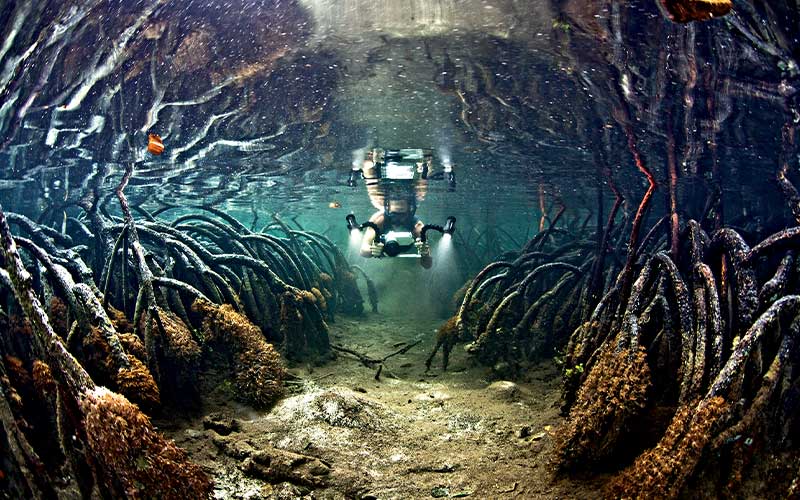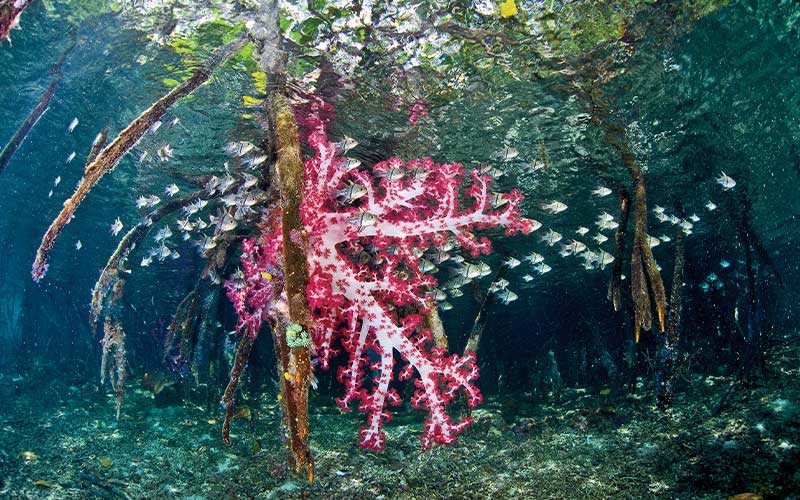Fluttering green canopies 30 feet above the waterline shade tranquil worlds, worlds unknown to most divers. The canopies are the living roofs of dense mangrove forests that grow along the convoluted shores of islands and other coastal areas. Environmental conditions in these semiaquatic habitats are persistently warm, humid and shallow. Mangrove trees do not merely compose wet forests, they produce a fundamental ecological unit bonding the land to the sea. Without them, tropical marine life would be far less abundant, and diving coral reefs and other marine habitats would be a very different experience.
Complex Beauty
Organisms that live even part of their lives in the shifting conditions where mangrove communities evolved have a difficult existence. Only 50 to 60 species of trees play significant roles in the world’s mangrove forests, and each day the plants and animals living within them must deal with hours of desiccation as the tide recedes and then hours of flooding during high tide. Soft mud low in oxygen and high in sulfur and bacteria comprises a sludgelike soil in which most terrestrial plants would wither. Ravaging wind and waves continually batter mangroves, and water salinity varies dramatically according to the amount of local rainfall. These ever-changing conditions have led to peculiar adaptations that take advantage of the rich resources that exist where the land and sea converge. One of these adaptations is viviparity in mangrove trees: Seeds germinate on the parent tree before dispersing. Trees have also evolved unique salt-exclusion methods and grow complex, supportive root systems. Prop roots anchor and brace the trees, while pneumatophores, or aerial roots, allow them to breathe above the waterlogged soil.

Only possible during high tides, diving in this environment is an inimitable experience, unlike any other in the underwater world. Beams of sunlight pierce the water, contrasting with the dark shade among roots. Along forest edges, curved prop roots support sponges, bivalves, barnacles, tunicates and even a few corals. Entering narrow creeks that wind deep into the forests, divers can explore an immensely different tropical environment than the ones commonly advertised. Juvenile great barracuda, mangrove snapper, mullet and archerfish dart silently into the thickets of roots as divers’ bubbles disturb the water. Amphibious mudskippers cling to tree trunks. Juvenile bluefin trevally hound silversides, which flow by schools of hovering orbiculate cardinalfish, which remain absolutely still among the dim shadows. Above the waterline, drooping branches covered with mosses, orchids, ferns and bromeliads arch over placid creeks whose smooth surfaces conceal unexpected marine diversity. But there is more to these habitats than their alien aesthetics; they are critical contributors to the health of other equatorial ecosystems.
These fringing forests grow along meandering coastlines and act, in part, as intricate filters, keeping sediment runoff generated on land from drifting onto and slowly smothering nearby coral reefs. Mangrove canopies shield the shallows from direct sunlight, moderating temperatures while contributing oxygen, absorbing carbon dioxide and sequestering carbon. They produce organic compounds, a source of food for bacteria, gastropods, crustaceans and a variety of fish. Many fish and invertebrates divers are used to viewing on reefs, such as pipefish, barracuda, snapper, sharks, rays, sponges, corals, crabs and tunicates, use mangroves for refuge, feeding and breeding. Research performed in Palau indicates that up to 70 percent of the local commercially important fish spend at least part of their lives within mangrove habitats. Most likely due to the availability of shelter and prevalent food, recent studies have shown habitats in close proximity to mangroves have at least twice the fish abundance and species richness compared to those more distant. In addition, hundreds of bird species are known to use the habitat for nesting and feeding. Mangrove forests, sea-grass beds and coral reefs form what has been aptly dubbed by Marcus Sheaves of James Cook University an “interconnected habitat mosaic.”

Continually in flux, mangroves are able to grow and maintain communities of marine and terrestrial organisms in equilibrium as long as human interference isn’t drastic. Joseph E. Armstrong, professor of botany at Illinois State University, states, “Mangroves are certainly the most misunderstood and most threatened of all types of tropical forests. People just don’t understand that coastal fisheries depend on mangroves for productivity and as the breeding grounds of many ocean species, so when mangrove forests are destroyed to construct shrimp ponds, a common situation in Southeast Asia, people are robbing Peter to pay Paul. Though mangroves protect coastal areas from severe storms and tsunamis, these forests are widely viewed as waste areas to be cleared away. How many more incentives do governments need to institute protection for mangroves? Unfortunately, the voices of developers saying ‘progress’ and ‘profit’ sound loudly in political ears.”
Like all of Earth’s ecosystems, mangroves are at risk from climate change and associated sea level rise but other anthropogenic pressures are most threatening in the near term. Clearing, overharvesting, overfishing and pollution upset the ecological balance of mangrove food chains and alter local communities for the worse.

The Future of Forests
The key to mangrove forests’ future is for researchers, fishermen and divers to convince decision-makers worldwide that the forests are vitally important to coral reefs, commercial fisheries, coastal protection and even tourism. Although it may be possible to put a dollar value on mangroves, their ecological importance is much greater. Just as coral reefs are imperative for their role in fisheries and as carbon sinks, mangroves are no less significant. They play a role that protects and connects land and sea and thus deserve stringent legislative protection in all countries. The Mangrove Replenishment Initiative (MRI), begun as a local project in Florida but now a global program, could make a positive difference around the planet through education and replanting projects. It is apparent that conserving and effectively managing large swaths of this extraordinary habitat is essential to a healthy, ocean-covered world.
The ecological and evolutionary messages conveyed by the colors and fragrances of flooded forests can be divined only by thorough observation and exploration. The utility of these forests is as extraordinary as their beauty. Divers who take the time to observe first hand a mangrove, or indeed any living ecosystem, will be rewarded with a distinctive and often breathtaking experience. Seen from the inside, mangroves are a series of marvels, where intermingled organisms and habitats have made the most of where land and water unite.

What Can You Do?
Want to help preserve the mangrove forests?
- Get interested in mangroves, and learn as much as you can about them.
- Swim and dive within them, and see their uniqueness for yourself.
- Be aware of your food’s origins. Avoid shrimp raised in farms in former mangrove areas.
- Become involved. Visit www.mangroveactionproject.org and check out the Mangrove Action Project’s international work and events.
© Alert Diver — Q4 Fall 2011